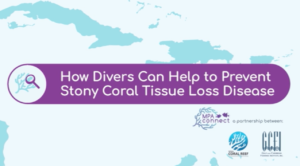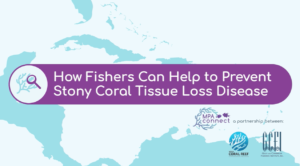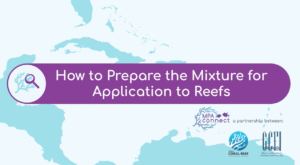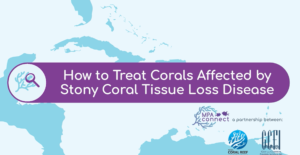STONY CORAL TISSUE LOSS DISEASE
Since it was first reported in Florida in 2014, Stony Coral Tissue Loss Disease (SCTLD), has now spread throughout the Wider Caribbean Region with cases in Jamaica, Mexico, Sint Maarten, the U.S. Virgin Islands, the Dominican Republic, the Turks and Caicos Islands, Belize, Sint Eustatius, Puerto Rico, The Bahamas, the British Virgin Islands, the Cayman Islands, Guadeloupe, St. Lucia and Honduras.
SCTLD spreads rapidly and affects some of the slowest-growing and longest-lived reef-building corals, including the brain, star and pillar corals. Scientists are uncertain about the cause of the disease but it is water-borne and can be spread by contact. As the disease continues to spread throughout the Caribbean MPAConnect, a partnership between GCFI and NOAA’s Coral Reef Conservation Program, has developed resource materials that will help with the identification, monitoring and treatment of the disease, which may be found below.
SCTLD spreads rapidly and affects some of the slowest-growing and longest-lived reef-building corals, including the brain, star and pillar corals (Table 1).
| High Susceptibility | Intermediate Susceptibility | Presumed Susceptibility | Low/No Susceptibility |
| Colpophyllia natans (Boulder brain coral) | Orbicella annularis (Lobed star coral) | Madracis auretenra (Pencil coral) | Porites porites (Finger coral) |
| Dendrogyra cylindrus (Pillar Coral) | Orbicella faveolata (Mountainous star coral) | Favia fragum (Golfball coral) | Porites divaricata (Thin finger coral) |
| Dichocoenia stokesii (Elliptical star coral) | Orbicella franksi (Boulder star coral) | Isophyllia sinuosa (Sinuous cactus coral) | Porites furcata (Branched finger coral) |
| Diploria labyrinthiformis (Grooved brain coral) | Montastraea cavernosa (Great star coral)** | Porites astreoides (Mustard hill coral) | Acropora palmata (Elkhorn coral) |
| Eusmilia fastigiata (Smooth flower coral) | Solenastrea bournoni (Smooth star coral) | Oculina diffusa (Diffuse ivory bush coral) | Acropora cervicornis (Staghorn coral) |
| Meandrina meandrites (Maze coral) | Stephanocoenia intersepta (Blushing star coral) | Oculina spp. (Bush corals) | |
| Pseudodiploria strigosa (Symmetrical brain coral) | Madracis decactis (Ten-ray star coral) | Cladocora arbuscula (Tube coral) | |
| Pseudodiploria clivosa (Knobby brain coral) | Agaricia agaricites (Lettuce coral)* | Scolymia spp. (Disc corals) | |
| Meandrina jacksoni (Whitevalley maze coral) | Agaricia spp. (Plate / saucer corals) | Isophyllia rigida (Rough star coral) | |
| Siderastrea siderea (Massive starlet coral)* | Mycetophyllia spp. (Cactus corals) | ||
| Mussa angulosa (Spiny flower coral) |
* varies from no to high susceptibility; **=sometimes high susceptibility;
Adapted from Atlantic and Gulf Rapid Reef Assessment Program, (AGRRA) 2020 and J. Lang (pers. comm.)
Scientists are uncertain about the cause of the disease but it is water-borne and can be spread by contact. As the disease continues to spread throughout the Caribbean MPAConnect, a partnership between GCFI and NOAA’s Coral Reef Conservation Program, has developed resource materials that will help with the identification, monitoring and treatment of the disease, which may be found below.
Posters
MPAConnect has designed posters designed to increase awareness about SCTLD amongst natural resource managers and divers. Copies of the posters may be found below in English, Spanish and French.
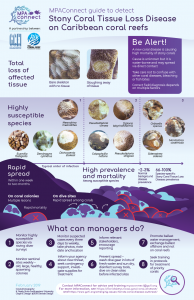
DETECTION
This poster seeks to help Caribbean marine natural resource managers monitor, identify and mitigate against SCTLD.
|
|
English | Spanish | |
|
Digital |
Spanish |
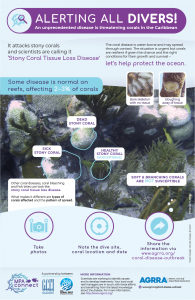
DIVER AWARENESS
Recreational divers may regularly dive the same reefs and explore areas that may otherwise not be monitored on a regular basis. This poster was designed to raise awareness amongst divers so they could identify possible cases of SCTLD and report it to the relevant authorities.
|
|
English | Spanish | |
|
Digital |
Spanish |
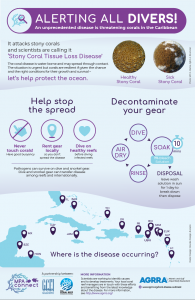
PREVENTION
Since the disease can be spread through contact this provides divers with
information on how to reduce the likelihood of transmission.
|
|
English | Spanish | |
|
Digital |
Spanish |
Webinars
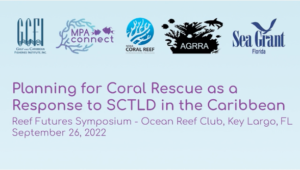 LEARNING EXCHANGE ON PLANNING FOR CARIBBEAN CORAL RESCUE AS A RESPONSE TO STONY CORAL TISSUE LOSS DISEASE
LEARNING EXCHANGE ON PLANNING FOR CARIBBEAN CORAL RESCUE AS A RESPONSE TO STONY CORAL TISSUE LOSS DISEASE
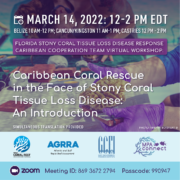 WEBINAR ON CARIBBEAN CORAL RESCUE IN THE FACE OF STONY CORAL TISSUE LOSS DISEASE
WEBINAR ON CARIBBEAN CORAL RESCUE IN THE FACE OF STONY CORAL TISSUE LOSS DISEASE
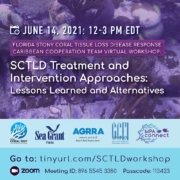 TECHNICAL WORKSHOP ON SCTLD TREATMENT AND INTERVENTION APPROACHES
TECHNICAL WORKSHOP ON SCTLD TREATMENT AND INTERVENTION APPROACHES
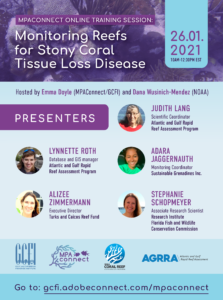 MONITORING REEFS FOR STONY CORAL TISSUE LOSS DISEASE
MONITORING REEFS FOR STONY CORAL TISSUE LOSS DISEASE
A webinar on Stony Coral Tissue Loss Disease was hosted on January 26th, 2021
The presentations made during the webinar may be accessed here:
– Judith Lang: Monitoring Reefs for Stony Coral Tissue Loss Disease
– Lynette Roth: AGRRA SCTLD & Bleaching Data Entry System
– Adara Jaggernauth: SCTLD Monitoring in St. Vincent and the Grenadines and Grenada.
– Stephanie Schopmeyer: SCTLD Reconnaissance and Monitoring in Florida
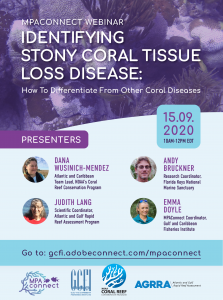 STONY CORAL TISSUE LOSS DISEASE WEBINAR
STONY CORAL TISSUE LOSS DISEASE WEBINAR
A webinar on Identifying Stony Coral Tissue Loss Disease was hosted on September 15, 2020. Please click on the links to access the presentations made by Judith Lang and Andy Bruckner
Documents
Monitoring Companion Guide
SCTLD monitoring fact sheet
This fact sheet is intended to help natural resource managers implement the most appropriate SCTLD monitoring protocols, based on their current management needs and can be downloaded here
SCTLD antibiotics treatment factsheet
This fact sheet is intended to help coral reef managers evaluate best practices for treatment of SCTLD and can be downloaded in English, Spanish and French
SCTLD template monitoring & response action plan for Caribbean marine natural resource managers:
Available in English | Spanish | French
In August 2019, MPAConnect’s 8th Peer To Peer Exchange provided natural resource managers from 17 countries/ territories in the Wider Caribbean Region with capacity building support to monitor and treat stony coral tissue loss disease. For more information on the learning exchange, and the resource materials provided, please click here.
Videos
How Divers Can Help to Prevent Stony Coral Tissue Loss Disease
How Fishers Can Help to Prevent Stony Coral Tissue Loss Disease
Since 2014 Stony Coral Tissue Loss Disease has affected 17 countries and territories throughout the Wider Caribbean Region. This video will provide information on how fishers can help identify and prevent the spread of disease throughout the region. Click here to view the video in English and Spanish
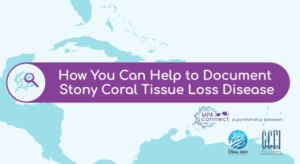 How to Document Stony Coral Tissue Loss Disease
How to Document Stony Coral Tissue Loss Disease
Since 2014 Stony Coral Tissue Loss Disease has been affecting reefs in the Wider Caribbean Region. In order to effectively treat the disease it must first be positively identified. This video explains how to document suspicious coral lesions, through the use of videos and photos, and how they can help with disease identification and monitoring. Click here to view the video in English and Spanish
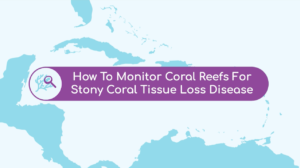 How to Monitor for Stony Coral Tissue Loss Disease (Monitoring Part 1)
How to Monitor for Stony Coral Tissue Loss Disease (Monitoring Part 1)
This video will show you how to monitor your reefs for stony coral tissue loss disease. It explains where to focus your monitoring efforts, how to do roving diver surveys, how to complete the coral disease datasheets, and understand the role of underwater photography. Click here to view the video in English and Spanish
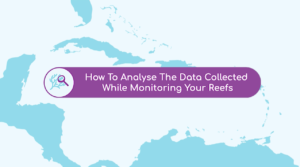 How to Analyze the Data Collected While Monitoring Your Reefs (Monitoring Part 2)
How to Analyze the Data Collected While Monitoring Your Reefs (Monitoring Part 2)
This video will show you how to analyze the data you’ve collected while monitoring your reefs in order to determine the prevalence of stony coral tissue loss disease, as well as when to re-visit your monitoring sites. Click here to view the video in English and Spanish
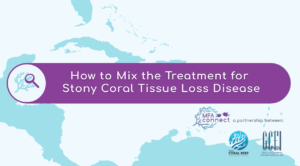 How to Mix the Treatment for Stony Coral Tissue Loss Disease (Treatment Mixture Part 1)
How to Mix the Treatment for Stony Coral Tissue Loss Disease (Treatment Mixture Part 1)
Currently, the most effective treatment for Stony Coral Tissue Loss Disease is the topical application of antibiotics, specifically amoxicillin, using a specially developed pharmaceutical paste called Base2B. The mixture, when applied along the margin of the disease lesion, helps prevent the progression of the disease. This video will show you how to prepare the mixture so that it can be successfully applied to diseased reefs. Click here to view the video in English and Spanish
How to Prepare the Mixture for Application to Reefs (Treatment Mixture Part 2)
With the amoxicillin / Base2B mixture prepared, this video will show you how to get the mixture ready for application.
Click here to view the video in English and Spanish
How To Treat Corals Affected by Stony Coral Tissue Loss Disease
Currently the only effective method being used to treat Stony Coral Tissue Loss Disease is the topical application of antibiotics, specifically amoxicillin, using a specially developed pharmaceutical paste called Base2B. This video will demonstrate how to apply the Base2B/amoxicillin mixture to corals that have been affected by the disease. Click here to view the video in English and Spanish
Press Releases
November 2022: Sharing strategies for coral rescue. Available in English and Spanish
April 2022: Recording Available: Caribbean coral rescue in the face of Stony Coral Tissue Loss Disease
January 2022: New Videos for Managers – Monitoring and Analysis for Stony Coral Tissue Loss Disease
January 2022: Nuevos vídeos para manejadores: el monitoreo y análisis para la Enfermedad de Pérdida de Tejido en Corales Duros
November 2021: UNEP/GCFI produce guidance document addressing Stony Coral Tissue Loss Disease in the Wider Caribbean
November 2020: NOAA Launches New Stony Coral Tissue Loss Disease Strategy at 73rd Annual Gulf and Caribbean Fisheries Institute
May 2020: MPAConnect and AGRRA Launch Caribbean Coral Disease Dashboard
October 2019: Alerting Divers to the Threat of Stony Coral Tissue Loss Disease
August 2019: Sharing Knowledge to Tackle Stony Coral Tissue Loss Disease
May 2019: Stony Coral Tissue Loss Disease Poster Goes Multi-Lingual (English) | Spanish | French

